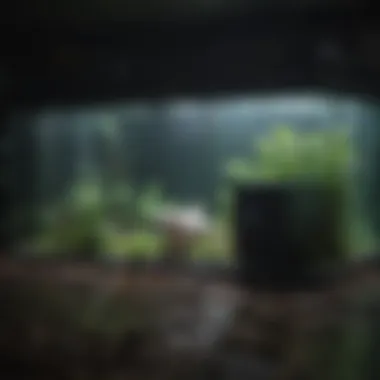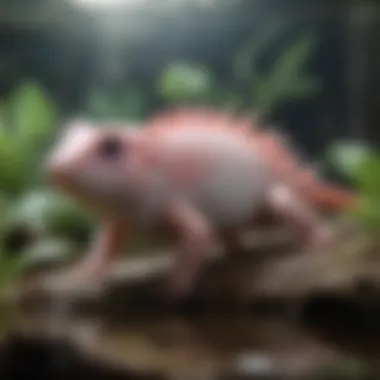Understanding Axolotl Chillers: Key to Optimal Care


Intro
Axolotls are remarkable creatures that have captured the interest of many aquarists and researchers. As aquatic amphibians, their unique attributes and care requirements demand specialized equipment for optimal habitat management. Proper temperature regulation is pivotal in maintaining a healthy environment for axolotls, and this is where chillers come in. This article aims to thoroughly examine chillers, emphasizing their function, installation, and best practices for ensuring the health and well-being of axolotls.
Animal Profile
General Overview
The axolotl, or Ambystoma mexicanum, is a neotenic salamander. They primarily retain their larval features throughout their adult life. This trait is fundamental for survival, allowing axolotls to thrive in their aquatic environment. Their unique external gills and varying color patterns make them easily recognizable among amphibians. They exhibit a fascinating form of regeneration that allows them to regrow limbs and organs without scarring.
Habitat and Distribution
Originating from the lake complex of Xochimilco near Mexico City, axolotls favor shallow waters with moderate temperatures. These lakes are rich in aquatic vegetation, providing ample shelter. Unfortunately, their natural habitat is under threat due to urban expansion, pollution, and invasive species. Understanding their habitat needs aids in recreating suitable environments in captivity.
Fascinating Facts
Unique Traits and Adaptations
Axolotls possess unique adaptations that set them apart from other amphibians. As aquatic creatures, they breathe through external gills and skin. Their regenerative abilities are exceptional, allowing them to regrow parts, including limbs and heart. This characteristic has earned them attention in scientific research.
Historical and Cultural Significance
Historically, axolotls have held a significant place in Mexican culture. Indigenous people revered them, linking them to Aztec mythology. They were often associated with the god Xolotl. This cultural heritage amplifies their relevance beyond just being aquatic pets.
Conservation Status
Current Population Trends
Axolotls are critically endangered in their natural habitat. The population has drastically declined, primarily due to habitat destruction and pollution. Captive breeding programs are now essential for their survival, ensuring a viable population exists outside their original environment.
Threats and Challenges
Several threats face axolotls today. Habitat loss due to urbanization poses a significant challenge. Additionally, the introduction of invasive species disrupts their ecosystem. Conservation efforts require a multidisciplinary approach to address these concerns effectively.
Care Tips for Pet Owners
Basic Needs and Requirements
To maintain the well-being of pet axolotls, several basic requirements must be met. Water conditions are crucial; maintaining a temperature between 16-18 degrees Celsius is vital. Axolotls require clean water, and using chillers can help regulate temperature. A habitat rich in hiding spots will reduce stress and encourage healthy behavior.
Health and Wellness Tips
Keeping axolotls healthy involves proper feeding and regular habitat maintenance. Providing a balanced diet, which includes pellets and live food, is important. Additionally, regular health checks can identify any signs of disease early on. Owners should be vigilant about water quality and perform regular tank changes.
Regular monitoring of temperature and water quality is essential for the optimal health of axolotls.
By understanding their unique needs and the role of chillers in habitat management, axolotl owners can ensure these fascinating creatures thrive in their care.
Prelude to Axolotls
Axolotls are remarkable creatures with unique needs. Understanding these needs is essential for anyone involved in their care. This section aims to provide foundational knowledge about axolotls, focusing on their origin, habitat, and physiological characteristics. Knowing about axolotls enhances the ability to create optimal environments for them, which in turn leads to healthier and more thriving animals.
Origin and Habitat
Axolotls, known scientifically as Ambystoma mexicanum, are native to the ancient lakes of Mexico, particularly Lake Xochimilco. This environment is increasingly rare due to urbanization and pollution. Originally, wild axolotls flourished in these freshwater ecosystems, where they could find shelter among aquatic plants and hide from predators.
Their habitat is characterized by cool waters, a variety of substrates, and ample cover. Axolotls tend to remain in the same areas over time, hence the importance of understanding how their natural habitat influences their care in captivity. Without the right environment, axolotls may become stressed, leading to health problems.
Axolotl Physiology


Axolotls possess distinct physiological traits that make them a subject of interest in science and aquaristics. They are noted for their regenerative abilities; they can regrow limbs, parts of their heart, and even sections of their brain. This remarkable phenomenon provides insight into biological regeneration.
In terms of physical characteristics, axolotls feature feathery gills that extend from their heads, which are crucial for respiration in the water. They have a broad, flat body and a distinct, wide head. Their skin comes in various colors, including wild-type, leucistic, and golden albino, which can affect their welfare under certain lighting conditions.
This section's information is critical in helping caretakers appreciate the normal functioning of axolotls. Recognizing physiological signs of stress or health issues can promote timely interventions and improve overall care. Proper understanding reinforces the goal of maintaining optimal conditions, where they can thrive in any setting.
Temperature Requirements for Axolotls
Understanding the temperature requirements for axolotls is fundamental for their care and well-being. These creatures, although resilient, rely on specific thermal conditions to thrive. Axolotls are ectothermic, meaning their body temperature aligns with their environment. Any significant deviation from their optimum temperature range can lead to stress, health issues, and, in severe cases, mortality.
Ideal Temperature Range
The ideal temperature range for axolotls is typically between 16°C to 18°C (60°F to 64°F). Keeping the tank water within this range is crucial for their metabolic processes. At optimal temperatures, axolotls exhibit healthy behaviors, such as active movement and eagerness to feed.
Conversely, temperatures above 20°C (68°F) can induce stress responses. When experiencing higher temperatures, axolotls may become lethargic. They can also be more susceptible to diseases when their environment becomes warm.
Maintaining a consistent temperature is essential. Fluctuations, even if minor, can affect the amphibian's health significantly. Owners should consider using accurate thermometers designed for aquarium use. Regular monitoring of water temperatures ensures that any necessary adjustments can be made promptly.
Proper temperature control is vital for preventing long-term health issues in axolotls.
Effects of Temperature on Health
Temperature directly influences the health and behavior of axolotls. One immediate effect of increased water temperature is an elevated metabolism. While this might seem beneficial, a higher metabolic rate demands more oxygen. In already warm conditions, oxygen levels can deplete, which can lead to hypoxia and eventual health crises.
Moreover, higher temperatures can encourage the growth of harmful bacteria and parasites. Common ailments, such as gill rot and fungal infections, are exacerbated by warm water. Such conditions create a hostile environment for axolotls, drastically increasing their stress levels.
In contrast, lower temperatures help maintain water quality and the overall health of axolotls. However, too low a temperature can lead to decreased activity and feeding. The balance is delicate; therefore, attentive care and monitoring are necessary.
In summary, understanding the ideal temperature range and its effects on health is critical for axolotl owners. It ensures these unique creatures remain vibrant and healthy, ultimately extending their lifespan and enhancing their quality of life.
The Role of Axolotl Chillers
Chillers play a crucial role in maintaining the health and well-being of axolotls. These devices help regulate water temperature, which is vital for the physiological needs of these aquatic creatures. Given that axolotls are ectothermic, their body temperature is significantly affected by the surrounding water. Therefore, an optimal water temperature must be maintained to ensure their growth and reproduction.
When temperature is controlled properly, axolotls display more natural behaviors and exhibit limited stress. If the conditions are inadequate, it can lead to health problems. Hence, understanding chillers is key for any axolotl owner.
Purpose of Chillers
The primary purpose of chillers is to maintain a stable and suitable temperature for axolotls. Fluctuations in water temperature can cause stress and even serious health issues. A chiller functions by removing excess heat from the aquarium water, ensuring its temperature remains constant. This is especially important in warmer climates or during summer months when the ambient temperature can rise.
Key Benefits:
- Temperature Stability: Chillers help sustain the ideal temperature range of 16-18 °C, preventing harmful spikes.
- Stress Reduction: By providing a constant environment, axolotls experience less stress, which is essential for their overall health.
- Disease Prevention: Keeping water cool reduces the risk of bacterial growth and disease.
Types of Chillers Available
There are mainly two types of chillers used in aquaculture: refrigeration-based chillers and fan-driven chillers. Each type has its unique applications and characteristics, making them suitable for various environments and user needs.
Refrigeration-based Chillers
Refrigeration-based chillers are generally the more powerful option. They use refrigerant to cool the water much like a refrigerator chills air. The key characteristic of these units is their ability to lower water temperatures efficiently and effectively.
- Benefits: These chillers offer precise temperature control. They are excellent for larger tanks or setups that need consistent cooling throughout the year.
- Disadvantages: They tend to be more expensive and may require more maintenance due to refrigeration components. Noise can also be a concern for some models.
Fan-driven Chillers
Fan-driven chillers are another option that utilizes fans to circulate air over water. The water is cooled primarily through evaporation. They are known for being the more energy-efficient choice.
- Benefits: These units are usually lower in cost and easier to maintain due to fewer mechanical parts. They consume less energy compared to refrigeration chillers.
- Disadvantages: They may not provide the same level of cooling power and might not be suitable for larger tanks or extreme temperature control needs.
In summary, the choice of chiller depends on specific requirements of the tank setup. Consider factors like tank size and local climate conditions when selecting the right option.


Choosing the Right Chiller
Selecting an appropriate chiller is critical for maintaining the ideal living conditions for axolotls. Different chillers serve varying tank sizes and environmental requirements, making the choice essential for the health and well-being of these creatures. We will examine specific elements related to choosing the right chiller, its benefits, and considerations that should guide your decision-making process.
Factors to Consider
When selecting the best chiller for your axolotl habitat, understanding key factors such as tank size and temperature control accuracy is vital. Both elements significantly influence the effectiveness and efficiency of your chosen chiller.
Tank Size
The tank size plays a crucial role in determining chiller selection. A larger tank may require a more powerful chiller capable of maintaining the desired temperature range efficiently. Chillers designed for smaller tanks might struggle to keep the water cool in larger setups, leading to potential overheating, which can be harmful to axolotls.
Key characteristic: The correct tank size influences the cooling capacity and efficiency of a chiller.
Why it is important: A chiller accurately matched to tank size ensures proper temperature regulation, which is vital for axolotl care.
Remember: Choosing a chiller that matches your tank size also minimizes energy consumption and operational costs over time.
Unique feature: Many chillers have adjustable settings for different tank sizes, allowing users flexibility.
Advantages: Properly sized chillers enhance overall energy efficiency and reduce the risk of temperature fluctuations.
Disadvantages: Oversized chillers may lead to excessive energy use while undersized models can fail to maintain temperatures.
Temperature Control Accuracy
Temperature control accuracy is another key feature to consider when choosing a chiller. The ability to maintain precise temperature levels is essential for the health of axolotls, as they are ectothermic animals that depend on their environment to regulate body temperature. A chiller with poor temperature accuracy may result in unsteady conditions, which stress the animals.
Key characteristic: High-accuracy chillers bring stability to the aquatic environment, offering better temperature control than basic models.
Why it is important: Precise temperature regulation helps prevent health issues and promotes growth and general wellbeing in axolotls.
Unique feature: Some advanced chillers utilize digital displays for temperature monitoring and real-time adjustments.
Advantages: Accurate temperature control provides a safer habitat for axolotls, allowing owners peace of mind.
Disadvantages: These models often come at a higher price point, which might discourage some users.
Cost Considerations
Cost is an important aspect to take into account when selecting an axolotl chiller. The price varies significantly based on features, brand, and capacity. It's vital to balance the initial investment with long-term operational costs. Selecting a cheaper option may seem appealing initially, but it could lead to higher costs due to inefficiencies or increased maintenance requirements.
Key points to consider:
- Research different models and brands to find the best price-to-feature ratio.
- Calculate potential energy costs associated with running different chillers over time.
- Factor in warranty and service options offered with each model.
To conclude, choosing the right chiller involves several careful considerations. Factors such as tank size and temperature control accuracy directly impact the well-being of your axolotls. By evaluating these aspects and considering the associated costs, you can make an informed decision that supports optimal care for these unique aquatic creatures.
Installation of Chillers
Installing chillers in axolotl habitats is a step that holds significant importance. Proper installation ensures that the chiller functions efficiently, maintaining the desired temperature for axolotls. A well-calibrated system safeguards the health of these unique creatures. Inadequately installed chillers may lead to erratic temperature control, which can adversely affect axolotl well-being.
Preparation Steps
Before starting the installation, some specific preparation steps are necessary. First, assess the tank size that will house the axolotls. This helps to determine the chiller's cooling capacity requirements. The volume of water, environment and the heat generated by tank equipment are critical factors to consider. Next, clean the chiller and ensure it is in good working condition. Collect all necessary tools and read the manufacturer's instructions carefully. Thorough preparation will aid in smooth installation and streamline the operation of the chiller.
Always prioritize safety during installation. Ensure power is turned off and follow all guidelines provided by the device manufacturer.
Connecting the Chiller


Connecting the chiller is a straightforward but essential process. Begin by placing the chiller near the water source for optimal water flow. The inlet and outlet tubes need to be secured. Proper alignment prevents leaks and ensure efficient cooling. Most chillers use a pump to circulate water. Check that the pump is compatible with the chiller and the tank size. Once everything is connected, it's important to test the system. Turn on the chiller and monitor the water temperature. Adjust settings as needed to achieve the ideal range for axolotls, generally between 16°C and 18°C (60°F to 64°F).
In addition to these steps, regular checks after installation help maintain performance. Monitor how the system runs, ensuring there are no leaks or irregularities in temperature. By ensuring effective installation, axolotl owners can create a stable and healthy environment for their pets.
Maintenance of Axolotl Chillers
Proper maintenance of axolotl chillers is crucial for the optimal care of these unique creatures. Regular maintenance ensures the chiller functions effectively, providing the stable temperatures necessary for axolotl health. Neglecting maintenance can lead to temperature fluctuations, which can directly impact the well-being of your axolotls.
Key benefits of maintaining your axolotl chiller include:
- Enhanced Performance: Well-maintained chillers operate more efficiently, ensuring that the water temperature remains consistently within the ideal range.
- Increased Lifespan: Regular maintenance can prolong the lifespan of the chiller, saving costs in the long run.
- Early Detection of Issues: Routine checks can help identify problems early, preventing more significant issues from developing later on.
To achieve these benefits, it is crucial to understand the various aspects of routine maintenance and troubleshooting common issues.
Routine Checks
Conducting routine checks on your axolotl chiller is one of the foremost responsibilities of care in any aquatic environment. Regular checks help to ensure that the chiller is working as it should, minimizing the risk of sudden temperature spikes or drops, which can be detrimental to axolotl health.
The key elements to focus on during routine checks are:
- Temperature Readings: Regularly verify the water temperature with a reliable thermometer. This ensures that your chiller is functioning as expected.
- Visual Inspection: Inspect the chiller for any visible signs of wear or damage. Look for leaks, corrosion, or anything that seems out of place.
- Cleaning: Dust and debris can build up on the chiller’s components, reducing its efficiency. Clean air vents and surfaces as needed.
- Water Quality Monitoring: Testing the water for any chemical imbalances is important. Keeping the water clean helps the chiller work efficiently.
By making routine checks part of your regular maintenance schedule, you can effectively manage the health of your axolotls and ensure the chiller performs optimally.
Troubleshooting Common Issues
Despite preventive measures and regular maintenance, issues with axolotl chillers can occasionally arise. Knowing how to troubleshoot these problems is essential for maintaining a stable environment. Here are some common issues and possible solutions:
- Inconsistent Temperature: If you notice fluctuations in water temperature, first check if the chiller is turned on and set to the correct temperature. If it is functioning but still inconsistent, it may require cleaning or inspection for blockages.
- No Cooling Effect: If the chiller is running but not cooling, ensure that the water is circulating properly through the system. Inspect the pump and make sure there are no obstructions.
- Strange Noises: Unusual sounds can indicate a problem with internal components. If audible noise persists, consider letting a professional assess the chiller to avoid further damage.
- Electrical Issues: If the chiller fails to turn on, check the power supply and any connections. Replacing a faulty power cable or plug may resolve the issue.
Addressing issues as they arise can prevent more serious failure and ensure a stable and healthy environment for your axolotls.
Health Implications of Improper Temperature
The health of axolotls hinges significantly on their environment, primarily temperature. A poorly regulated habitat can lead to varied health concerns. Understanding the health implications of improper temperature can empower axolotl owners to create a better space for their pets. Temperatures that fluctuate outside the ideal ranges can lead to stress, disease, and even mortality.
Disease Prevention
Common Ailments
Axolotls can suffer from several health issues if their environmental temperature is not maintained at optimal levels. Common ailments include fungal infections, bacterial infections, and gill rot. Each of these conditions can become serious if not caught early, emphasizing the importance of monitoring water temperature closely. Fungal infections often arise in cool water, whereas, bacterial infections thrive in warmer temperatures. Monitoring these ailments is crucial as they can severely impact an axolotl’s quality of life.
Signs of Distress
Recognizing signs of distress in axolotls is vital for their welfare. Symptoms such as lethargy, floating abnormally, and changes in appetite can indicate temperature issues. The key characteristic of signs of distress is their sudden onset, usually correlated with sharp temperature changes. This section serves an educational purpose, informing axolotl owners to be vigilant and proactive. Understanding these behaviors allows for swift intervention, increasing the chances of recovery.
Long-term Effects of Temperature Fluctuations
Chronic fluctuations in temperature can have long-term consequences on an axolotl's health. It can lead to compromised immune systems, making them more susceptible to illness over time. Additionally, consistent stress resulting from improper environmental conditions could affect their growth and reproductive capabilities. Maintaining a stable habitat not only promotes their immediate well-being but also ensures longer-term health stability.
"Stable environmental conditions are essential for the overall health of axolotls. Temperature management is a key factor in preventing health issues."
Epilogue
Understanding the significance of axolotl chillers is vital for anyone interested in creating a sustainable habitat for these unique creatures. Proper temperature regulation is crucial in ensuring their overall health and well-being. By maintaining an optimal environment, axolotls can thrive, thus preventing diseases and promoting longevity.
Summary of Key Points
- Temperature Regulation: Axolotls require specific temperature ranges to remain healthy. Chillers help in maintaining stable conditions within their aquatic habitat.
- Health Implications: Fluctuations in temperature can lead to serious health issues, including stress and susceptibility to diseases. Understanding these risks is essential for all axolotl owners.
- Chiller Types and Installation: Knowledge of different types of chillers, such as refrigeration-based and fan-driven, allows for informed decisions on which system best suits individual needs.
- Maintenance: Regular checks and awareness of common chiller issues prevent larger problems, contributing to a stable living environment for axolotls.
Future Considerations
As interest in keeping axolotls continues to grow, advancements in chiller technology may enhance user experience and effectiveness. Potential areas for improvement include:
- Energy Efficiency: Future chillers could focus on lower energy consumption without compromising effectiveness.
- Smart Technology Integration: Incorporating smart technology for remote monitoring could further assist in maintaining optimal conditions.
- Customizable Solutions: Research into customizable chillers tailored to specific tank sizes or species may enhance the suitability for various types of axolotls.
Thus, keeping abreast of emerging trends and technology will equip axolotl owners with the knowledge necessary for optimal care.















